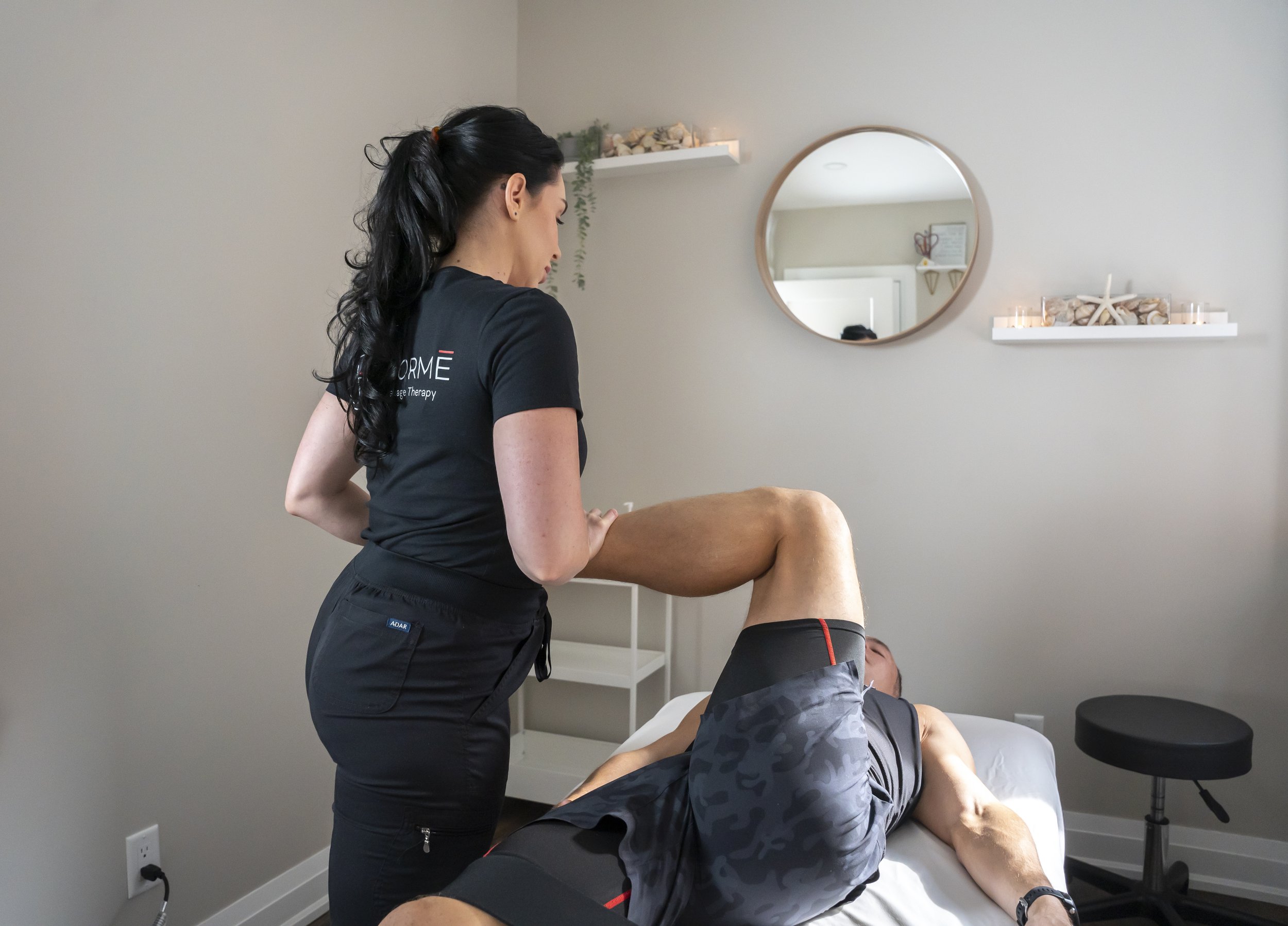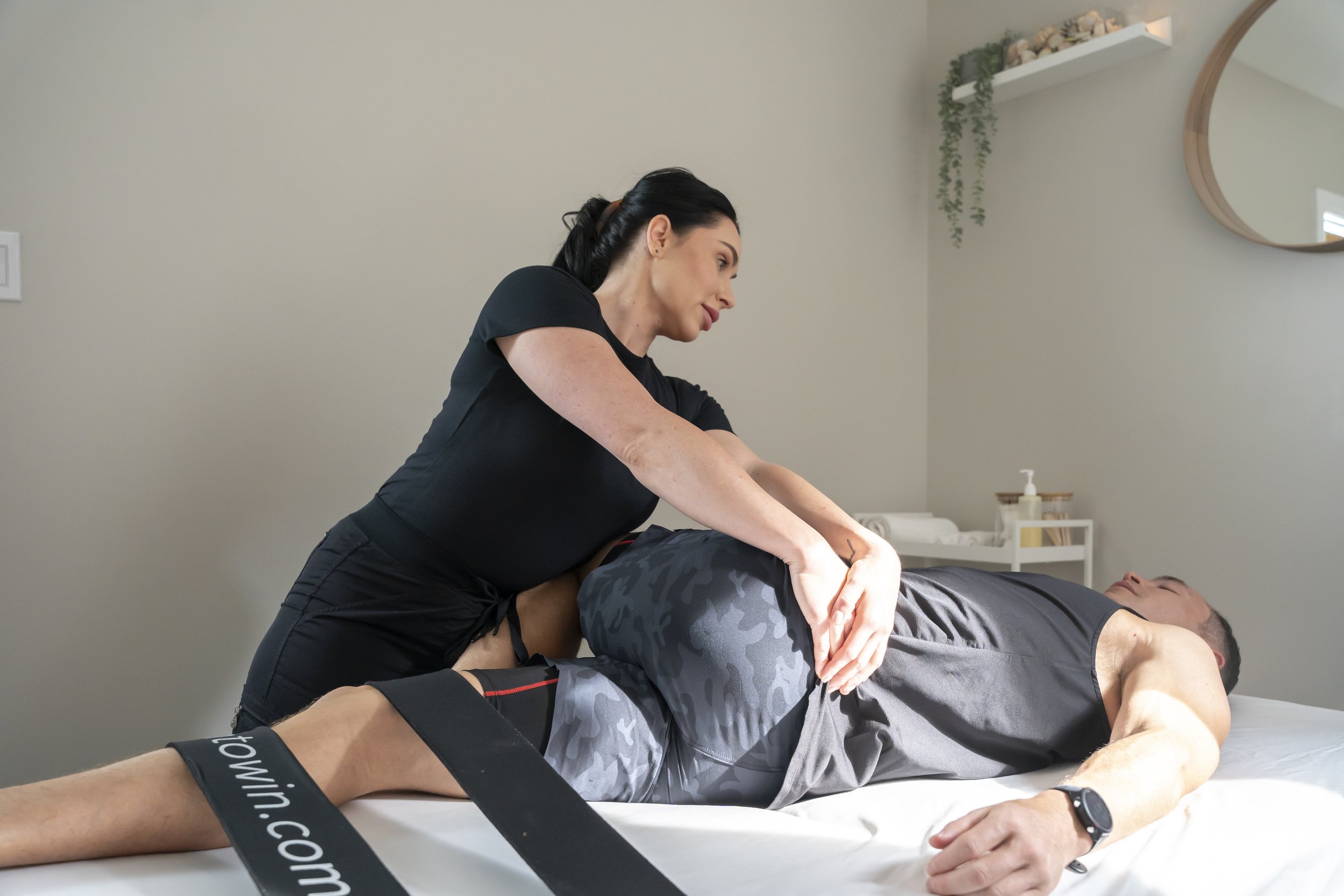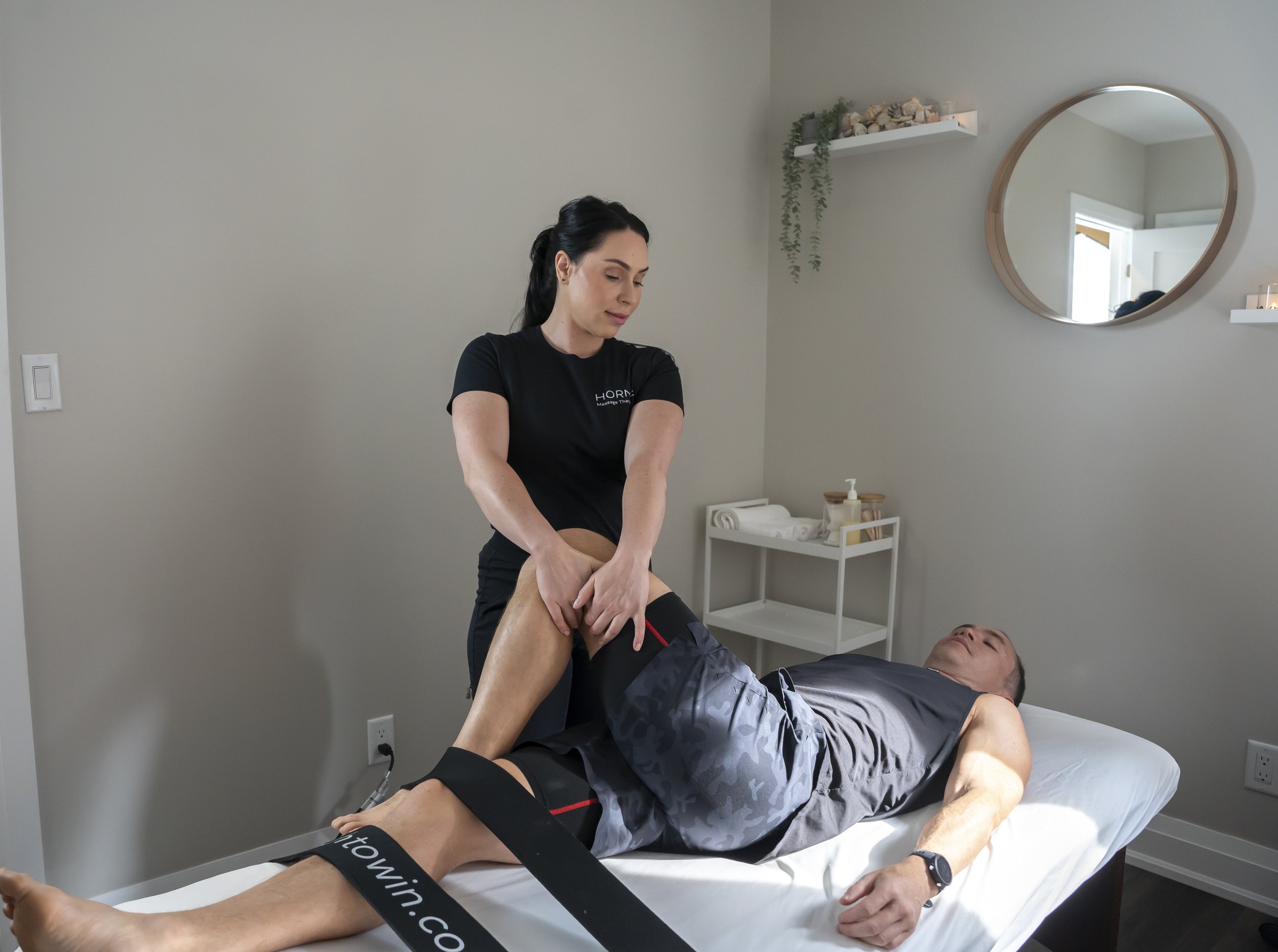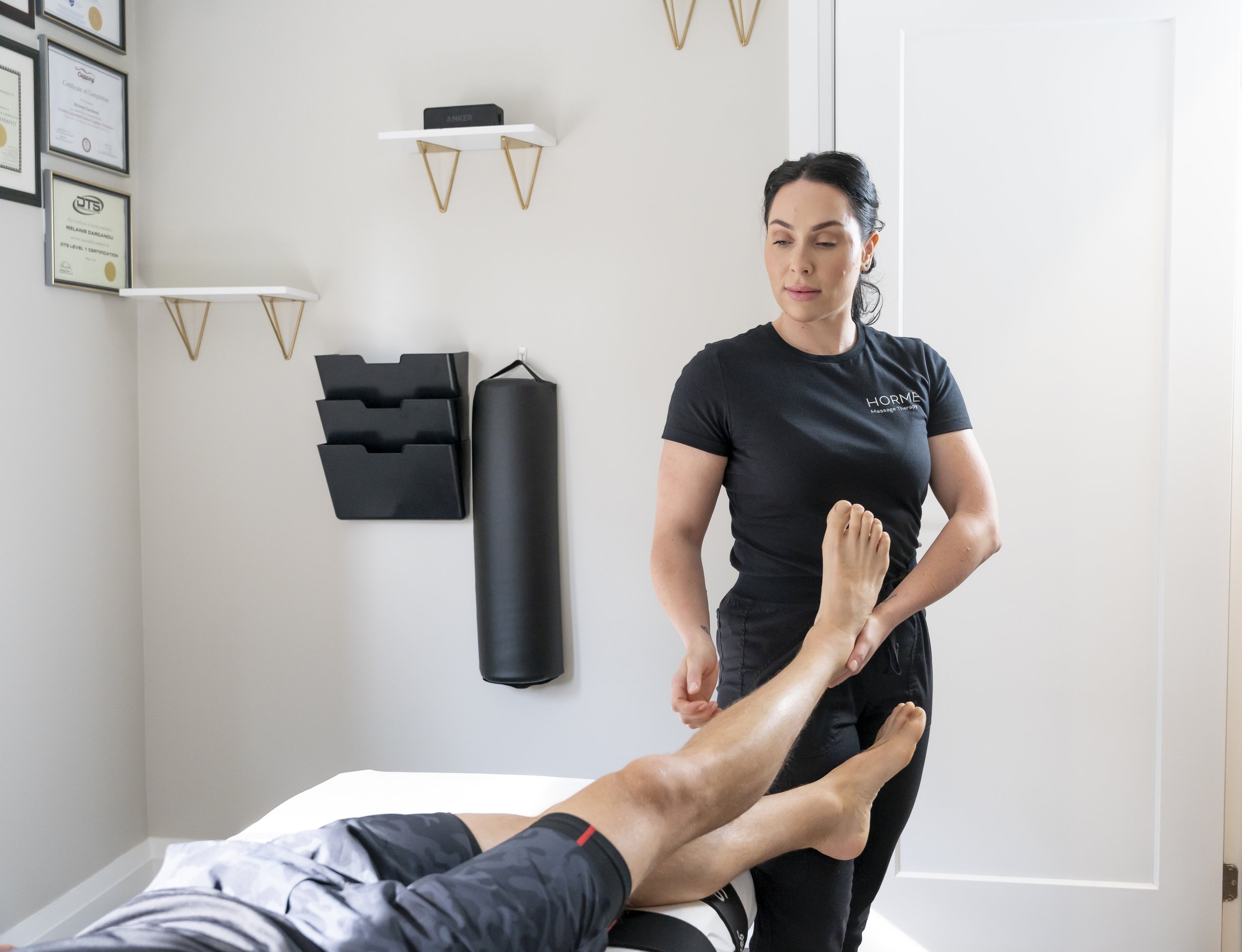Unlocking Flexibility and Pain Relief [A Comprehensive Guide to Fascial Stretch Therapy]
/Welcome to the journey of unlocking your body's full potential through the transformative practice of Fascial Stretch Therapy (FST). As a certified FST practitioner, I'm excited to guide you through the ins and outs of this innovative approach to enhancing flexibility, relieving pain, and promoting overall wellness.
My Journey with Fascial Stretch Therapy
I truly can’t say enough positive things about FST. I’m certified Fascial Stretch Therapist with Stretch to Win, trained with DTS Fitness Education in Toronto. When I discovered the amazingness of FST I wanted to shout it from the rooftop! Why isn’t EVERYONE doing this?! I was a personal trainer with Goodlife Fitness at the time and took every opportunity to perform it on my clients. I was so surprised at its effectiveness that I felt like I was performing miracles. In one session my clients had no pain where there was before, could move better in their workouts and could feel a noticeable change in their bodies, saying they “felt lighter”. Miraculous!
I started having so many FST clients that my manager had a meeting with me to remind me that my focus was on building a PT business and not an FST business. So, I created STRETCH Therapy & Wellness in 2019, my FST focused health & wellness practice that has now blossomed into a multi modal integrated practice.





Understanding Fascial Stretch Therapy
What is Fascial Stretch Therapy? Fascial Stretch Therapy, often abbreviated as FST, is a dynamic and effective technique designed to improve flexibility, reduce pain, and optimize the body's movement patterns. Unlike traditional static stretching, FST is a more holistic approach that targets the fascial system—a complex network of connective tissues that surround muscles, bones, and joints.
Fascial Stretch Therapy is a unique system of assisted stretching that focuses on the entire fascial network. The fascia, a web-like structure that encases our muscles and organs, plays a crucial role in our body's ability to move freely. FST combines stretch positions using specific tension, joint mobilizations and proprioceptive neuromuscular facilitation (say that 5 times fast! lol) FST employs gentle, pain-free movements to release tension and increase the length of the fascia, promoting improved flexibility and mobility.
The Frederick Stretch System by Stretch To Win Institute as it’s called today, was originally created by Ann Frederick, Arizona US, in 1995, that became popular amongst professional athletes (NBA and the US Olympic team). It has since grown reached global recognition and continues to gain popularity.
The Science Behind FST To comprehend the effectiveness of FST, it's essential to grasp the science behind it. Fascia is not just a passive wrapping; it's a dynamic tissue that responds to movement and stress. According to a study published in the Journal of Bodywork and Movement Therapies, FST has been shown to positively impact fascial extensibility, promoting greater flexibility and ease of movement.
FST is different from regular static stretching. The use of tension, joint mobilizations and stretching techniques such as PNF or Proprioceptive Neuromuscular Facilitation allows the therapist to deliver a deeper, more effective stretch.
Thomas Myers and the Fascial Meridians
Fascial Stretch Therapy is closely connected to the groundbreaking work of anatomist and author Thomas Myers. Myers introduced the concept of fascial meridians, which are continuous lines of fascia that run throughout the body, connecting various muscle groups and providing a framework for movement.
Myers' work, outlined in his book "Anatomy Trains," emphasizes the interconnectedness of the body through these myofascial pathways. The recognition of fascial meridians in FST allows practitioners to address not just isolated muscles but entire lines of tension, offering a more comprehensive and effective approach to stretching and improving mobility.
Benefits of Fascial Stretch Therapy
One of the primary benefits of FST is the significant improvement in flexibility beyond what traditional stretching methods can achieve. A study in the Journal of Sports Science & Medicine found that participants who underwent FST experienced greater gains in flexibility compared to those who followed a conventional static stretching routine. This is largely because an individual cannot replicate the position, tension, angle and traction needed to target the entire fascial line at once.
Pain Relief and Injury Prevention FST is not only about flexibility; it's also a powerful tool for pain relief and injury prevention. Research published in the International Journal of Sports Physical Therapy suggests that FST can reduce muscle soreness and enhance recovery after strenuous physical activity. This makes it a valuable addition to the toolkit for athletes and fitness enthusiasts. From my experience with clients, it also helps with muscular imbalances causing pain such as; scoliosis, plantar fasciitis, tendinitis, thoracic outlet syndrome, headaches etc…
Posture Correction: FST can assist in the correction of posture long term. By stretching restricted tissues and creating space in the joint, FST allows an opportunity for the body to rebalance by helping to reengage weakened muscles and lengthening shortened ones. As with all therapy however, it only offers temporary opening for long lasting changes. Without a long term solution for correcting the underlying problem, ie; performing strength training to correct muscle imbalances, the postural issues will eventually return. Therapy is not a “done for you” magic solution, but a conduit, the creation of an opportunity for healing. I focus a lot on this in my practice. Yes, maintenance is ongoing, but repeating the same therapy without improvement or lasting change is just a band-aid. I like to offer my clients a way out of their chronic pain.
Who Can Benefit from Fascial Stretch Therapy?
Athletes and Fitness Enthusiasts If you're an athlete or someone who enjoys an active lifestyle, FST can be a game-changer. It complements athletic training by addressing imbalances, improving flexibility, and reducing the risk of injuries. Professional athletes like NBA players have incorporated FST into their routines for its ability to enhance performance. FST serves a key role in improving overall sport performance, recovery and longevity.
Individuals with Chronic Pain For those dealing with chronic pain conditions such as back pain, sciatica, or arthritis, FST offers a non-invasive approach to managing discomfort. A study in the Journal of Pain Research highlights the positive effects of FST on reducing pain intensity and improving function in individuals with chronic low back pain. I’ve personally witnessed the benefits of FST on people who had scoliosis, plantar fasciitis, thoracic outlet syndrome and chronic headaches.
Individuals who have a sedentary job also benefit tremendously. FST helps maintain joint health, mobility and encourages circulation which is ideal for those who don’t get enough movement during the day. Motion is lotion as they say and with joint mobilizations synovial fluid is preduced in the joints offering improved movement, decrease in stiffness and increased range of motion. I’ve actually had clients tell me that their feet and fingers felt warm for the first time in years. Initial testing revealed they had insufficient blood flow to those areas but during their first session felt a rushing sensation of blood to their hands and feet. I highly recommend FST to all my computer bound clients.
Who Should Not do FST?
Those who are hypermobile or who have ligament laxity conditions should be very careful with FST. Although many people who are hypermobile complain of tension, stretching may actually only make things worse. Because the ligaments of the joints are already loose, FST may only add to the laxity causing worsening symptoms. When a client comes to me and presents with hypermobility, I usually prescribe a strength protocol instead.
Are you “feeling tight” but not getting anywhere with constant stretching? Although this could be for other reasons which I will cover in another post, hypermobility may be one of them. A common test for hyper mobility that I use with clients is the Beighton score. I consists of a series of joint range of motion tests. You can calculate your Beighton here:
What to Expect During a Fascial Stretch Therapy Session
A typical FST session involves a series of assisted stretches performed on a treatment table with stretching straps. As a certified practitioner, I'll guide you through a range of motions designed to target specific areas of the body. Each stretch is tailored to your individual needs and goals.
Your first appointment includes:
1. Interview & health history to discuss and establish your goals for treatment
2. Assessment: Identify limitations or areas of restriction that may be contributing to your issue. This can include various movement and range of motion tests.
3. The stretch itself: You on the table with me guiding you through various stretches targeting specific fascial lines.
Potential sensations during FST
It's normal to wonder about potential discomfort during FST. However, the emphasis is on gentle, pain-free movements. Communication is key—Because sensations are subjective to the individual, we establish an “Intensity scale” prior to beginning. On a scale of 1-10 (10 being very intense) I recommend aiming for a 5-6 intensity out of 10. You should feel a stretch but still be able to relax into the position. If you feel like you’re tensing and can’t relax, it’s too much and I readjust for better comfort.
The Importance of Mindful Breathing
Maintaining Slow Diaphragmatic and Nasal Breathing During an FST session, I encourage clients to focus on slow, diaphragmatic breathing through the nose. This intentional approach to breathing serves multiple purposes. Firstly, it promotes a state of relaxation, allowing the body to release tension more effectively. As you inhale deeply through the nose, the diaphragm engages, signaling the body's nervous system to shift into a parasympathetic state, commonly known as the "rest and digest" mode. This, in turn, reduces stress hormones, creating an optimal environment for the fascial tissues to respond positively to the stretches.
Regulating the Nervous System The connection between the breath and the nervous system is profound. The parasympathetic nervous system is responsible for promoting relaxation and recovery, while the sympathetic nervous system triggers the body's "fight or flight" response. By maintaining slow diaphragmatic and nasal breathing, we encourage the dominance of the parasympathetic system, fostering an environment of calm and receptivity. Research in the Journal of Neurophysiology indicates that conscious diaphragmatic breathing can modulate the autonomic nervous system, contributing to overall well-being.
Enhancing Results through Mindful Breathing In the context of FST, mindful breathing serves as a catalyst for improved outcomes. When the body is in a relaxed state, the fascial tissues are more pliable, allowing for a more profound and effective stretch. Additionally, conscious breathing heightens body awareness, helping clients tune into subtle sensations and release areas of tension. This synergy of breath and movement amplifies the therapeutic benefits of FST, creating a holistic experience that extends beyond the physical realm.
Incorporating Fascial Stretch Therapy into Your Wellness Routine
Combining FST with Other Wellness Practices FST can seamlessly integrate into your existing wellness routine. Whether you practice yoga, receive regular massages, or engage in other forms of exercise, FST complements and enhances the benefits of these activities. It's about creating a holistic approach to your overall well-being. At Stretch, FST can be integrated into general and therapeutic sessions or on as a stand alone treatment.
Fascial Stretch Therapy is a powerful and versatile tool for unlocking your body's full potential. Whether you're an athlete aiming to improve performance, someone dealing with chronic pain seeking relief, or simply looking to enhance your flexibility, FST can make a meaningful difference in your life.
If you're ready to experience the benefits of Fascial Stretch Therapy, I invite you to schedule a session with me. Share your thoughts and experiences in the comments, and let's embark on this journey to improved flexibility, pain relief, and optimal wellness together.
References:
The Science Behind Fascial Stretch Therapy. Journal of Bodywork and Movement Therapies.
Effects of Fascial Stretch Therapy on Flexibility. Journal of Sports Science & Medicine.
Fascial Stretch Therapy for Pain Reduction. International Journal of Sports Physical Therapy.
FST in Chronic Low Back Pain Management. Journal of Pain Research.
Myers, T. (2009). Anatomy Trains: Myofascial Meridians for Manual and Movement Therapists. Churchill Livingstone.


